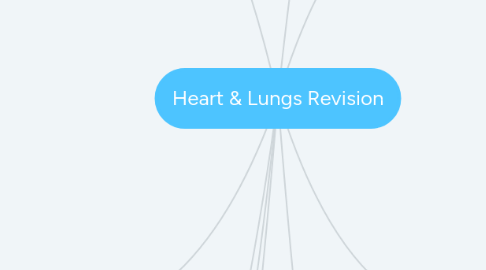
1. Blood Vessels
1.1. There are three types
1.1.1. Artery
1.1.1.1. Artery caries oxygenated blood away from the heart.
1.1.1.2. Pulmonary artery will carry deoxygenated blood from the right ventricle of the heart to the lungs for oxygenation.
1.1.1.3. Aorta is the main artery
1.1.1.4. An Artery has a thick outer wall, small lumen and a thick layer of muscle and elastic fibre to absorb the high pressure of the blood.
1.1.2. Vein
1.1.2.1. Vein carries deoxygenated blood to the heart.
1.1.2.2. Vein contains valves - to prevent blood going in the wrong direction.
1.1.2.3. A vein has a thin layer of muscle and elastic fibre, large lumen and a fairly thin outer wall.
1.1.3. Capillary
1.1.3.1. In the capillary diffusion occurs
1.1.3.2. Capillary have a very small lumen and a wall made of a single layer cell
1.1.3.3. Carbon Dioxide > Capillary> Diffusion
1.1.3.3.1. oxygen
1.1.3.3.2. glucose
1.1.3.4. Coronary Arteries come off the Aorta and supply the heart muscle with blood
1.1.3.4.1. Coronary Arteries > Capillary > Diffusion > Vein>Heart
2. Blood
2.1. There are 4 main components of Blood
2.1.1. Red Blood Cells
2.1.1.1. Red Blood Cells contain no nucleus, meaning that it can fit in more Haemoglogin
2.1.1.2. It has a Biconcave shape , meaning that it increases the surface area which then absorbs more oxygen
2.1.1.3. For Oxygen to leave the red blood cells, diffusion is needed.
2.1.1.4. Haemoglobin
2.1.1.4.1. oxygen+Haemoglobin = Oxyhaemoglobing
2.1.1.5. A Haemoglobin is a red protein responsible for transporting oxygen in the blood of vertebrates.
2.1.1.6. Its molecule comprises four subunits , each one containing an atom of Iron.
2.1.2. White Blood Cells
2.1.2.1. White Blood Cells fight pathogens to protect the body
2.1.2.2. Two Types of White Blood Cells
2.1.2.2.1. Phagocytes - Engulf Pathogens
2.1.2.2.2. Lymphocytes - Produce Antibodies
2.1.3. Platelets
2.1.3.1. Platelets help clot the blood and forms a scab
2.1.4. Plasma
2.1.4.1. Plasma straws coloured liquid which is the main transport of the blood
2.2. Blood is a tissue
3. Coronary Heart Disease
3.1. Coronary artery disease is caused by plaque buildup in the wall of the arteries that supply blood to the heart.
3.1.1. Plaque is made up of cholesterol deposits. Plaque buildup causes the inside of the arteries to narrow over time. This process is called atherosclerosis.
4. BMI
4.1. The BMI is defined as the body mass divided by the square of the body height, and is universally expressed in units of kg/m², resulting from mass in kilograms and height in metres.
4.2. BMI=
4.2.1. Body mass in kg
4.2.2. (height in metres) Squared
4.2.3. (height in metres) Squared
5. Risk Factors
5.1. Communicable Diseases
5.1.1. A type of disease that is contagious since the agent of the disease may be transmitted from infected host to another
5.2. Non-Communicable Disease
5.2.1. Diseases that are not contagious
6. Heart
6.1. Pumps blood around the body
6.1.1. to keep the cells alive
6.2. The heart is a double ciculatory system. This means to complete one circuit its through the heart twice
6.3. Located in the chest, more to the left side
6.4. Its a muscle
6.5. Veins & Arteries are attached to it
6.6. 4 chambers
6.6.1. Right Atrium & Left Atrium
6.6.2. Right Ventricle & Left Ventricle
6.6.3. The right side of the heart pumps deoxygenated blood. And the left pumps oxygenated blood.
6.6.4. Valves
6.6.4.1. Valves are located in between the right atrium and the right ventricle. Also in between the left atrium and the left ventricle
6.6.4.2. The point of valves is to stop the blood going back to the chambers
7. Lungs
7.1. The main function of the lungs is to withdraw oxygen, to feed the organisms. Also it takes in oxygen and breathe out carbon dioxide.
7.2. How does oxygen move into the lungs and out? When the diaphragm contracts, oxygen moves through the trachea (windpipe) into the lungs, creating a large surface area due to lower pressure. After the diaphragm relaxes, creating higher pressure which pushes the oxygen out of the lungs
7.3. Gas Exchange
7.3.1. Diffusion happens in the internal environment to the external, of the lungs.
7.3.2. Alveoli Adaptation
7.3.2.1. Moist
7.3.2.2. Large Surface Area
7.3.2.3. Thin - 1 cell thick
7.3.2.4. Good blood supply
8. Fats
8.1. Cholesterol
8.1.1. A fatly substance that is made in the body
8.1.2. There are 2 types of cholesterol
8.1.2.1. Low density Lipoproteins - Bad cholesterol
8.1.2.2. High density Lipoproteins - good cholesterol
8.1.3. Why we need cholesterol?
8.1.3.1. To make cell membranes and to maintain normal hormone production
8.1.4. With cholesterol, the pressure increases leading to the heart pumping and working harder, leading to heart disease.
8.1.5. Causes of high cholesterol
8.1.5.1. too much saturated fat and a poor diet
8.1.5.2. inherited
8.1.5.3. lack of exercise
8.1.6. How can high cholesterol be decreased
8.1.6.1. reduce saturated fats replace with unsaturated fats
8.1.6.2. regular physical exercise can increase HDL
8.1.6.3. Medicine called statins.
8.2. Fat helps you absorb vitamins A, D, E, and K, the so-called fat-soluble vitamins. Fat also fills your fat cells and insulates your body to help keep you warm.
9. Diet and Exercise
9.1. What makes a healthy diet
9.1.1. carbohydrates
9.1.2. proteins
9.1.3. fats
9.1.4. vitamins
9.1.5. minerals
9.1.6. fibres
9.1.7. water
9.2. Your body uses carbohydrates, proteins and fats to release the energy you need to live and to build new cells
9.3. You need small amounts of vitamins and minerals for your body to work, without them you will suffer deficiency diseases. If you don't have a balanced diet then you will end up malnourished
9.4. If we take in too much energy, we put on weight.If we don't take energy we become underweight
9.4.1. Health problems being underweight
9.4.1.1. Poor development
9.4.1.2. Risk of deficiency diseases
9.4.1.3. Risk of infection
9.4.2. Health problems of being overweight
9.4.2.1. Risk of arthritis
9.4.2.2. Risk of type 2 diabetes
9.4.2.3. High blood pressure
9.4.2.4. Heart disease

